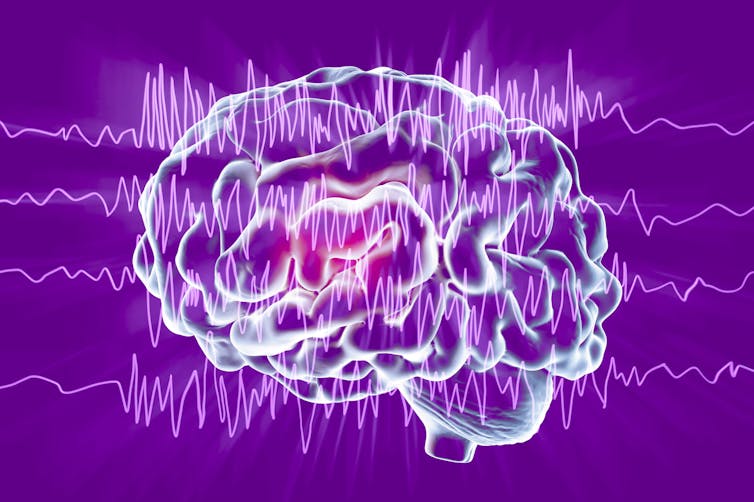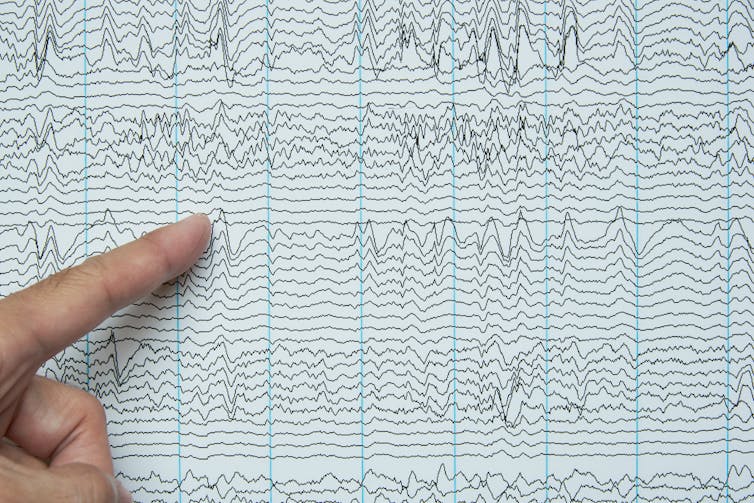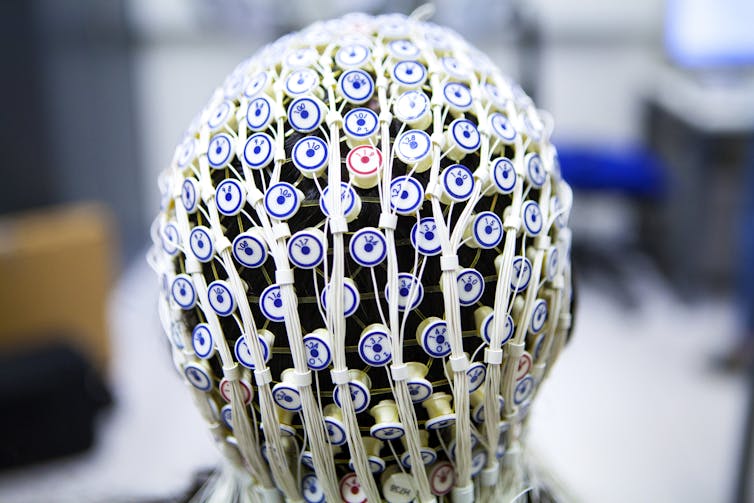
Kateryna Kon/Science Photo Library via Getty Images
Electroencephalography, or EEG, was invented 100 years ago. In the years since the invention of this device to monitor brain electricity, it has had an incredible impact on how scientists study the human brain.
Since its first use, the EEG has shaped researchers’ understanding of cognition, from perception to memory. It has also been important for diagnosing and guiding treatment of multiple brain disorders, including epilepsy.
I am a cognitive neuroscientist who uses EEG to study how people remember events from their past. The EEG’s 100-year anniversary is an opportunity to reflect on this discovery’s significance in neuroscience and medicine.
Discovery of EEG
On July 6, 1924, psychiatrist Hans Berger performed the first EEG recording on a human, a 17-year-old boy undergoing neurosurgery. At the time, Berger and other researchers were performing electrical recordings on the brains of animals.
What set Berger apart was his obsession with finding the physical basis of what he called psychic energy, or mental effort, in people. Through a series of experiments spanning his early career, Berger measured brain volume and temperature to study changes in mental processes such as intellectual work, attention and desire.
He then turned to recording electrical activity. Though he recorded the first traces of EEG in the human brain in 1924, he did not publish the results until 1929. Those five intervening years were a tortuous phase of self-doubt about the source of the EEG signal in the brain and refining the experimental setup. Berger recorded hundreds of EEGs on multiple subjects, including his own children, with both experimental successes and setbacks.

Hans Berger/Über das Elektrenkephalogramm des Menchen. Archives für Psychiatrie. 1929; 87:527-70 via Wikimedia Commons
Finally convinced of his results, he published a series of papers in the journal Archiv für Psychiatrie and had hopes of winning a Nobel Prize. Unfortunately, the research community doubted his results, and years passed before anyone else started using EEG in their own research.
Berger was eventually nominated for a Nobel Prize in 1940. But Nobels were not awarded that year in any category due to World War II and Germany’s occupation of Norway.
Neural oscillations
When many neurons are active at the same time, they produce an electrical signal strong enough to spread instantaneously through the conductive tissue of the brain, skull and scalp. EEG electrodes placed on the head can record these electrical signals.
Since the discovery of EEG, researchers have shown that neural activity oscillates at specific frequencies. In his initial EEG recordings in 1924, Berger noted the predominance of oscillatory activity that cycled eight to 12 times per second, or 8 to 12 hertz, named alpha oscillations. Since the discovery of alpha rhythms, there have been many attempts to understand how and why neurons oscillate.
Neural oscillations are thought to be important for effective communication between specialized brain regions. For example, theta oscillations that cycle at 4 to 8 hertz are important for communication between brain regions involved in memory encoding and retrieval in animals and humans.

undefined undefined/iStock via Getty Images Plus
Researchers then examined whether they could alter neural oscillations and therefore affect how neurons talk to each other. Studies have shown that many behavioral and noninvasive methods can alter neural oscillations and lead to changes in cognitive performance. Engaging in specific mental activities can induce neural oscillations in the frequencies those mental activities use. For example, my team’s research found that mindfulness meditation can increase theta frequency oscillations and improve memory retrieval.
Noninvasive brain stimulation methods can target frequencies of interest. For example, my team’s ongoing research found that brain stimulation at theta frequency can lead to improved memory retrieval.
EEG has also led to major discoveries about how the brain processes information in many other cognitive domains, including how people perceive the world around them, how they focus their attention, how they communicate through language and how they process emotions.
Diagnosing and treating brain disorders
EEG is commonly used today to diagnose sleep disorders and epilepsy and to guide brain disorder treatments.
Scientists are using EEG to see whether memory can be improved with noninvasive brain stimulation. Although the research is still in its infancy, there have been some promising results. For example, one study found that noninvasive brain stimulation at gamma frequency – 25 hertz – improved memory and neurotransmitter transmission in Alzheimer’s disease.

BSIP/Collection Mix: Subjects via Getty Images
A new type of noninvasive brain stimulation called temporal interference uses two high frequencies to cause neural activity equal to the difference between the stimulation frequencies. The high frequencies can better penetrate the brain and reach the targeted area. Researchers recently tested this method in people using 2,000 hertz and 2,005 hertz to send 5 hertz theta frequency at a key brain region for memory, the hippocampus. This led to improvements in remembering the name associated with a face.
Although these results are promising, more research is needed to understand the exact role neural oscillations play in cognition and whether altering them can lead to long-lasting cognitive enhancement.
The future of EEG
The 100-year anniversary of the EEG provides an opportunity to consider what it has taught us about brain function and what this technique can do in the future.
In a survey commissioned by the journal Nature Human Behaviour, over 500 researchers who use EEG in their work were asked to make predictions on the future of the technique. What will be possible in the next 100 years of EEG?
Some researchers, including myself, predict that we’ll use EEG to diagnose and create targeted treatments for brain disorders. Others anticipate that an affordable, wearable EEG will be widely used to enhance cognitive function at home or will be seamlessly integrated into virtual reality applications. The possibilities are vast.
Erika Nyhus, Associate Professor of Psychology and Neuroscience, Bowdoin College
This article is republished from The Conversation under a Creative Commons license. Read the original article.



















































